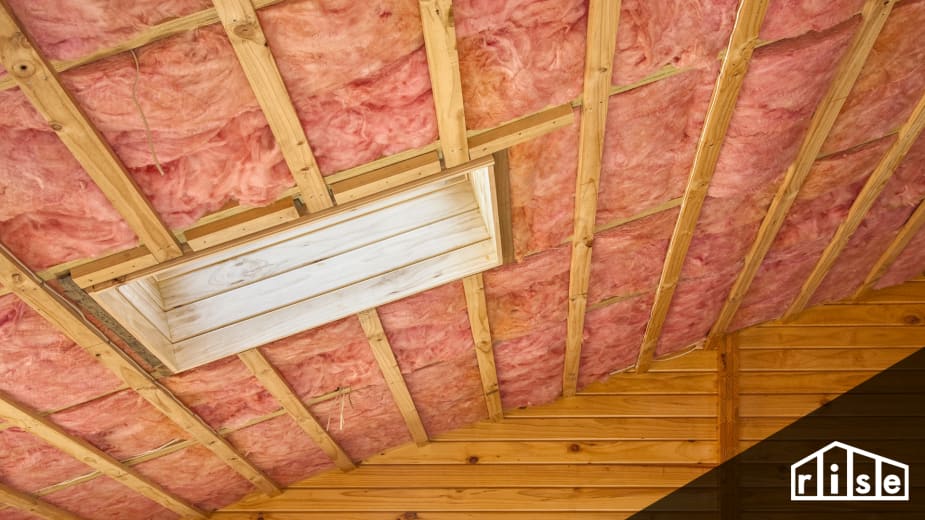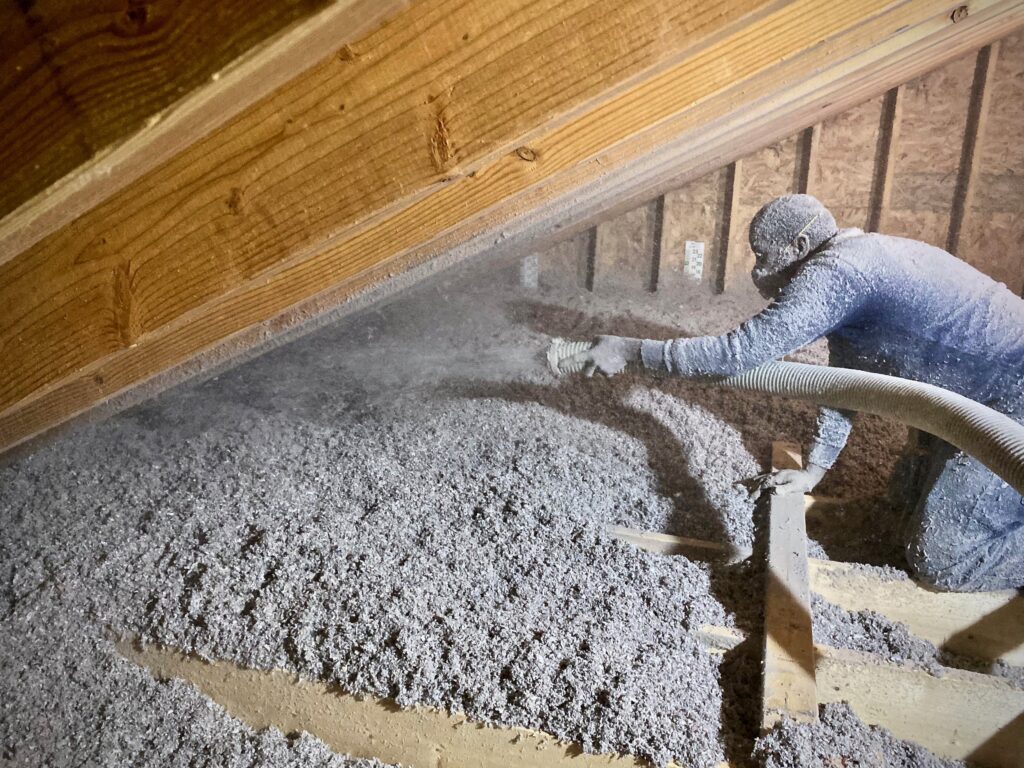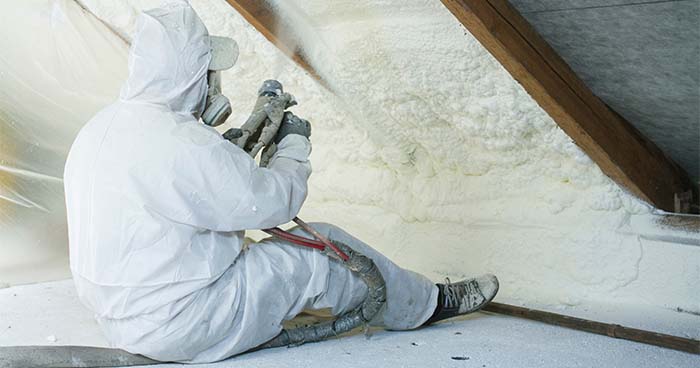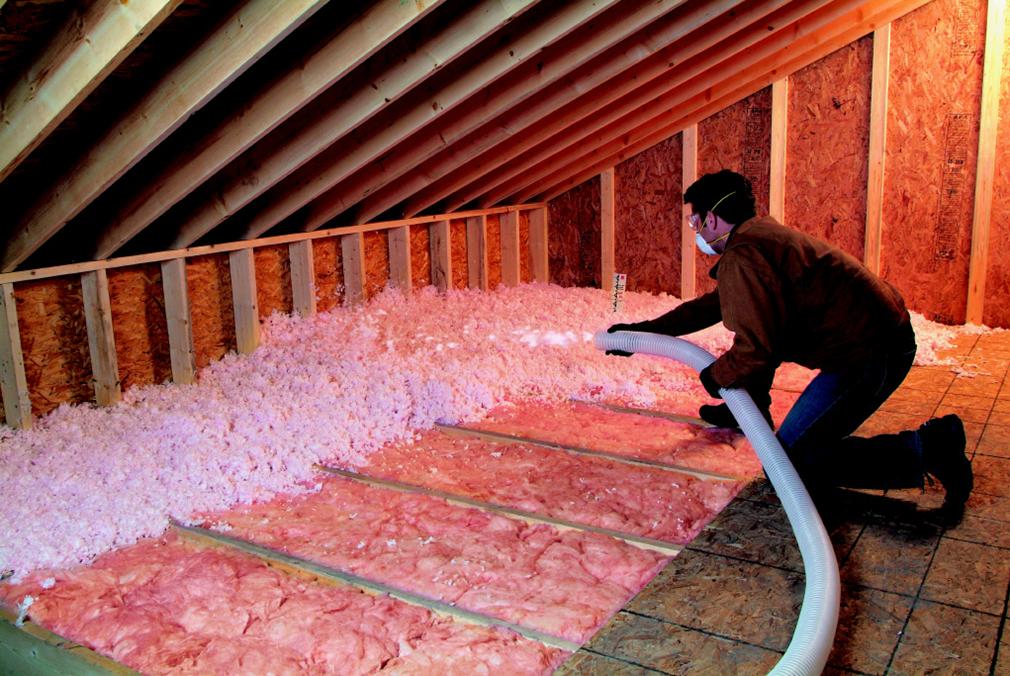The 4 Types of Attic Insulation & Their Pros and Cons
Effective attic insulation is essential for preserving the heat generated by your heating system and preventing energy loss. As you embark on the task of insulating your attic, it’s crucial to explore the available options, weighing the pros and cons to make an informed decision that aligns with your property, budget, and priorities. The four main types of attic insulation—fiberglass, cellulose, spray foam, and reflective insulation—each come with distinct advantages and considerations. Fiberglass insulation, widely used and cost-effective, requires careful handling to avoid skin irritation. Cellulose insulation, made from recycled paper, is eco-friendly, but professional installation may be necessary. Spray foam insulation offers versatility and tight sealing but often requires professional expertise. Reflective insulation, with its reflective foil-faced materials, can redirect heat but is most effective when used in combination with other insulation types. By understanding the characteristics of each option, you can make a well-informed decision to enhance your home’s energy efficiency and comfort.
1. Fiberglass Batt Insulation

Fiberglass batt insulation stands as the foremost and enduring choice for attic insulation, characterized by its cotton-candy-like appearance and widespread popularity among homeowners. Comprising tiny slivers of glass fibers derived from sand and recycled material, fiberglass batts are large, rolled-up sheets fused together with a chemical vapor that acts as an adhesive. The enduring appeal of fiberglass batt insulation lies in its numerous advantages. It is inherently eco-friendly, with the fiberglass itself originating from sand, a renewable energy source. The inclusion of a flame-proof vapor barrier enhances fire resistance. Additionally, fiberglass batts maintain structural integrity, rarely shrinking or collapsing due to air pockets formed during production. The insulation’s straightforward installation process has made it a favorite for DIY enthusiasts, allowing homeowners to avoid installation fees. Furthermore, fiberglass batt insulation provides soundproofing benefits, minimizing external noises and retaining internal sound within the property. The combination of its environmental friendliness, fire resistance, structural stability, ease of installation, and soundproofing properties solidifies fiberglass batt insulation as a favored and enduring choice for attic insulation.
The Advantages of Fiberglass Batt Insulation
Fiberglass batt insulation offers several advantages that contribute to its enduring popularity among homeowners:
- Eco-Friendly Composition: Fiberglass, the primary material in batt insulation, is created from sand, which qualifies as a renewable energy source. This eco-friendly composition aligns with the growing emphasis on sustainable building practices.
- Flame-Proof Vapor Barrier: The inclusion of a flame-proof vapor barrier enhances the insulation’s fire-resistant properties. This feature not only contributes to home safety but also provides an additional layer of protection against potential fire hazards.
- Structural Integrity: Fiberglass batts maintain their structural integrity over time. The formation of air pockets during production ensures that the insulation rarely shrinks or collapses. This durability contributes to the long-term effectiveness of the insulation.
- Straightforward Installation: The installation process for fiberglass batt insulation is straightforward, making it an accessible choice for do-it-yourself (DIY) enthusiasts. Homeowners opting for DIY installation can take advantage of the material’s ease of handling and avoid additional installation fees.
- Soundproofing Properties: Beyond its thermal insulation capabilities, fiberglass batts also provide effective soundproofing. This feature helps minimize external noises, creating a quieter living environment, while also containing internal sounds within the property.
- Cost-Effective Option: Fiberglass batt insulation is often cost-effective compared to some other insulation materials. Its affordability makes it an attractive choice for homeowners looking to enhance their home’s energy efficiency without exceeding their budget.
The combination of these advantages positions fiberglass batt insulation as a reliable and well-rounded option for attic insulation, meeting both environmental considerations and practical needs for homeowners.
The Disadvantages of Fiberglass Batt Insulation
While fiberglass batt insulation has numerous advantages, it also comes with certain disadvantages that homeowners should consider:
- Risk of Injury: The material consists of tiny slivers of glass fibers, posing a risk of skin irritation and discomfort during handling. Protective gear, such as gloves and a mask, is often recommended to minimize this risk.
- Harmful Vapor Barrier: The vapor barrier used in fiberglass batt insulation can be harmful if touched or inhaled. Proper precautions, including the use of protective equipment, are necessary during installation to ensure the safety of individuals handling the material.
- Sensitivity to Moisture: Fiberglass batt insulation is not resistant to moisture. If the insulation gets wet, it may lose its effectiveness in retaining heat. Drying out can be a slow process, potentially leading to prolonged performance issues.
- Potential for Mold Growth: Moisture absorption by fiberglass batt insulation can create conditions conducive to mold growth. This not only affects the insulation’s performance but also poses health risks associated with mold exposure.
- Attractiveness to Pests: Fiberglass batts are appealing to rodents and other pests, making them a potential habitat. This attractiveness can lead to rodent infestations, requiring additional pest control measures to address.
Despite these disadvantages, many homeowners find fiberglass batt insulation to be a suitable and cost-effective choice for attic insulation. Mitigating these drawbacks often involves taking proper safety precautions during installation and addressing potential moisture-related issues promptly.
2. Blown-In Fiberglass Insulation

If you’re drawn to the benefits of fiberglass insulation but prefer an alternative to batts, blown-in fiberglass insulation may be a suitable choice for you. Blown-in fiberglass utilizes the same base material—fiberglass—eliminating the need for a vapor barrier. The key distinction lies in the distribution method. Instead of being rolled up like batts, blown-in fiberglass is applied through a blowing machine.
This method offers advantages such as improved flexibility in application, allowing for better coverage in hard-to-reach or irregular spaces. The absence of a vapor barrier simplifies the installation process and may contribute to cost savings. In fact, some sources suggest that this shift to blown-in fiberglass distribution could potentially result in energy bill savings of up to 35 percent.
The blowing process allows for more efficient filling of cavities and ensures a snug fit, enhancing the overall insulation performance. Homeowners considering blown-in fiberglass insulation can appreciate its versatility, ease of installation, and potential energy-saving benefits, making it a compelling option for those seeking effective and efficient attic insulation solutions.
The Advantages of Blown-In Fiberglass Insulation
Blown-in fiberglass insulation offers several advantages that make it a popular choice for homeowners seeking effective and efficient insulation solutions:
- Enhanced Coverage in Hard-to-Reach Spaces: The blowing method allows for better coverage in irregular or hard-to-reach areas within the attic. This flexibility ensures a more comprehensive insulation application compared to traditional batts.
- No Need for Vapor Barrier: Blown-in fiberglass insulation eliminates the need for a vapor barrier, streamlining the installation process. This simplification can contribute to both time and cost savings.
- Improved Energy Efficiency: Some sources suggest that the transition to blown-in fiberglass insulation can result in significant energy savings, potentially up to 35 percent on energy bills. The efficient distribution method ensures a snug fit and optimal insulation performance.
- Versatility in Application: The blowing machine allows for versatile application, making it suitable for various attic configurations and structures. This adaptability ensures that the insulation meets the specific needs of the space.
- Quick and Efficient Installation: The blowing process is generally quick and efficient, reducing the overall installation time. This can be particularly advantageous for homeowners looking for a timely insulation solution.
- Reduced Air Infiltration: Blown-in fiberglass insulation forms a tight and seamless barrier, minimizing air infiltration. This property contributes to improved energy efficiency by preventing heat loss through gaps and cracks.
- Fire Resistance: Fiberglass inherently possesses fire-resistant properties, enhancing the safety of the insulation material.
The advantages of blown-in fiberglass insulation, including enhanced coverage, simplified installation, energy efficiency, and versatility, make it an attractive option for homeowners looking to optimize attic insulation. These benefits collectively contribute to improved home comfort, energy savings, and a more effective insulation solution.
The Disadvantages of Blown-In Fiberglass Insulation
While blown-in fiberglass insulation offers several advantages, it also comes with certain disadvantages that homeowners should consider:
- Professional Installation Required: Blown-in fiberglass insulation typically requires professional installation. The use of a blowing machine and specialized equipment necessitates expertise to ensure proper coverage and effectiveness. This can result in additional installation costs.
- Initial Cost: The upfront cost of blown-in fiberglass insulation, including the expense of professional installation, can be higher compared to some other insulation options. Homeowners should weigh this initial investment against potential long-term energy savings.
- Settling Over Time: Blown-in fiberglass insulation may experience settling over time, leading to a reduction in its effectiveness. This settling can occur due to factors such as gravity and air movement within the attic.
- Moisture Sensitivity: Like other forms of fiberglass insulation, blown-in fiberglass is sensitive to moisture. If the insulation becomes wet, it may lose its thermal resistance and could take a considerable amount of time to dry out.
- Potential for Uneven Distribution: Achieving a consistent and even distribution of blown-in fiberglass insulation can be challenging, particularly in complex attic spaces with various obstructions. Uneven distribution may result in areas with insufficient insulation coverage.
- Limited DIY Options: Unlike some insulation types that are more DIY-friendly, blown-in fiberglass insulation often requires professional installation due to the specialized equipment involved. This limitation may be a drawback for homeowners who prefer to undertake insulation projects themselves.
Considering both the advantages and disadvantages, homeowners should carefully assess their specific needs, budget constraints, and preferences when deciding whether blown-in fiberglass insulation is the right choice for their attic. Seeking professional advice and a thorough understanding of the insulation’s characteristics can help make an informed decision.
3. Blown-In Cellulose

Blown-in cellulose insulation stands as another option for attic insulation, utilizing a blowing machine similar to blown-in fiberglass but with a distinct material composition. Unlike fiberglass, blown-in cellulose insulation is made from recycled materials, including wood-based products, newspapers, and cardboard. This eco-friendly approach aligns with sustainable building practices, contributing to the repurposing of recycled materials.
To enhance fire resistance, blown-in cellulose insulation is treated with substances such as boric acid during the manufacturing process. This treatment serves to flame-proof the insulation, providing an additional layer of safety for the attic space. Once prepared, the cellulose insulation is blown in using the machine, effectively filling the attic space and covering any gaps or voids.
Blown-in cellulose insulation offers a different set of characteristics compared to other insulation types, combining environmental friendliness with fire resistance. Homeowners considering attic insulation have the opportunity to explore this option, weighing its advantages and potential drawbacks to determine its suitability for their specific needs and priorities.
The Advantages of Blown-In Cellulose Insulation
Blown-in cellulose insulation presents several advantages that contribute to its popularity as an attic insulation option:
- Eco-Friendly Composition: Blown-in cellulose insulation is made from recycled materials, including wood-based products, newspapers, and cardboard. This eco-friendly composition aligns with sustainable building practices, promoting the repurposing of recycled materials.
- Effective Flame-Proofing: During the manufacturing process, blown-in cellulose insulation is treated with substances such as boric acid to enhance fire resistance. This flame-proofing treatment provides an additional layer of safety for the attic space.
- Excellent Thermal Performance: Cellulose insulation has good thermal resistance properties, helping to regulate temperature and enhance energy efficiency in the home. It contributes to maintaining a comfortable living environment by minimizing heat loss or gain.
- Seamless Coverage: The blowing machine allows for the seamless application of cellulose insulation, ensuring effective coverage and filling gaps or voids within the attic space. This method results in a uniform and thorough insulation layer.
- Cost-Effective Option: Blown-in cellulose insulation is often considered a cost-effective option, especially when compared to certain other insulation materials. Its affordability makes it an attractive choice for homeowners seeking an efficient insulation solution within budget constraints.
- Versatility in Application: The blowing method offers versatility in the application of cellulose insulation, making it suitable for various attic configurations and structures. This adaptability ensures that the insulation meets the specific needs of the space.
- Soundproofing Properties: Cellulose insulation exhibits sound-dampening qualities, contributing to the reduction of external noises and enhancing overall acoustic comfort within the home.
These advantages collectively position blown-in cellulose insulation as a well-rounded option for homeowners looking to improve energy efficiency, promote sustainability, and enhance the overall comfort of their living spaces.
The Disadvantages of Blown-In Cellulose Insulation
While blown-in cellulose insulation offers several advantages, it also comes with certain disadvantages that homeowners should consider:
- Moisture Sensitivity: Cellulose insulation is sensitive to moisture, and if it becomes wet, it may lose its thermal resistance and effectiveness. Proper installation and moisture management are crucial to prevent potential issues.
- Settling Over Time: Like other blown-in insulation types, cellulose insulation may experience settling over time. Factors such as gravity and air movement within the attic can contribute to a gradual reduction in its thickness and insulating properties.
- Professional Installation Recommended: Blown-in cellulose insulation often requires professional installation due to the use of specialized equipment. While some homeowners may opt for a DIY approach, achieving uniform and effective coverage may be challenging without professional expertise.
- Initial Cost: The upfront cost of blown-in cellulose insulation, including the expense of professional installation, can be higher compared to some other insulation options. Homeowners should weigh this initial investment against potential long-term energy savings.
- Fire Resistance Limited to Treatment: While cellulose insulation is treated with substances like boric acid for flame-proofing, the fire resistance is dependent on this treatment. Over time, the effectiveness of the flame-proofing treatment may diminish.
- Potential for Settling and Compaction: Over the long term, blown-in cellulose insulation may settle and compact, leading to a decrease in its insulating effectiveness. Periodic inspections and maintenance may be necessary to address any settling issues.
- Limited DIY Options: Achieving optimal results with blown-in cellulose insulation may require professional installation, limiting the viability of a DIY approach. Homeowners who prefer self-installation may find certain challenges associated with the blowing equipment and techniques.
Understanding both the advantages and disadvantages of blown-in cellulose insulation is essential for homeowners considering this option for their attic. Seeking professional advice, proper installation, and ongoing maintenance practices can help mitigate potential drawbacks and ensure the insulation’s long-term effectiveness.
4. Spray Foam Insulation
Spray foam insulation represents the final type of attic insulation and has gained increasing popularity due to its extensive benefits. Distinguishing itself from other insulation types, spray foam insulation is unique in that it starts as a liquid.
Once sprayed, the liquid foam undergoes a process of thickening, expansion, and solidification, ultimately transforming into a durable foam. This foam has the remarkable ability to conform to the space it fills, seamlessly sliding into gaps and voids. As it expands and solidifies, spray foam creates an airtight seal, effectively cutting off any potential escape routes for heat.
The versatility of spray foam insulation makes it a preferred choice for homeowners seeking a comprehensive and effective solution for their attic insulation needs. Its ability to provide a tight seal, adapt to irregular spaces, and offer superior thermal resistance has contributed to its growing popularity in both new constructions and retrofitting projects.

The Advantages of Spray Foam Insulation
Spray foam insulation comes with several advantages that contribute to its growing popularity as an effective and versatile insulation solution:
- Excellent Thermal Performance: Spray foam insulation provides superior thermal resistance, creating an effective barrier against heat transfer. This helps maintain a consistent and comfortable temperature within the home, leading to increased energy efficiency.
- Seamless Coverage: Unlike other insulation types, spray foam expands to fill gaps and voids seamlessly, creating a continuous and airtight barrier. This ability to conform to the space ensures that there are no gaps where heat can escape, providing optimal insulation coverage.
- Air Sealing Properties: Spray foam insulation acts as an effective air sealant, preventing drafts and minimizing air infiltration. This air sealing capability enhances energy efficiency by reducing the load on heating and cooling systems.
- Versatility in Application: Spray foam can be applied to various surfaces and configurations, making it suitable for attics with irregular shapes or hard-to-reach areas. Its adaptability allows for comprehensive coverage, even in challenging spaces.
- Long-lasting and Durable: Once cured, spray foam insulation forms a durable and long-lasting barrier. It does not sag, settle, or deteriorate over time, providing consistent thermal performance for an extended period.
- Moisture Resistance: Closed-cell spray foam insulation acts as a moisture barrier, preventing the intrusion of water and moisture into the attic space. This moisture resistance helps prevent issues such as mold growth and structural damage.
- Soundproofing Properties: In addition to thermal insulation, spray foam provides effective soundproofing. It minimizes the transmission of noise, contributing to a quieter and more comfortable indoor environment.
- Potential Energy Savings: The air sealing and superior insulation properties of spray foam can lead to significant energy savings over time. Reduced energy consumption for heating and cooling contributes to lower utility bills.
While spray foam insulation offers numerous advantages, it’s important to consider factors such as installation cost and the need for professional application. Homeowners should weigh these considerations against the long-term benefits to determine if spray foam insulation aligns with their specific needs and budget constraints.
The Disadvantages of Spray Foam Insulation
While spray foam insulation offers various advantages, it also comes with certain disadvantages that homeowners should consider:
- Higher Initial Cost: Spray foam insulation typically has a higher upfront cost compared to other insulation types. The expense is influenced by the materials used and the specialized equipment required for professional installation.
- Professional Installation Required: Applying spray foam insulation requires specialized equipment and expertise. Professional installation is often recommended to ensure proper mixing, application, and adherence to safety protocols. This can contribute to higher overall project costs.
- Limited DIY Options: Due to the complexities of the application process and the need for specialized equipment, spray foam insulation is not a practical DIY project for most homeowners. Professional installation is essential for achieving the desired results.
- Potential Health Risks during Installation: The application of spray foam insulation involves the use of chemicals, and improper installation can lead to off-gassing of volatile organic compounds (VOCs). Proper ventilation and adherence to safety guidelines are crucial during installation to mitigate potential health risks.
- Curing Time and Occupancy Restrictions: After application, spray foam insulation requires a curing time before the area can be occupied. This downtime can impact construction timelines or the use of the space.
- Potential for Over-application: Improper application or over-application of spray foam can lead to issues such as bowing of walls or other structural concerns. Precision is crucial to ensure the correct thickness and coverage.
- Limited Repair Options: Once spray foam insulation is in place, making modifications or repairs can be challenging. Accessing the foam for repairs may require cutting into walls or ceilings, potentially causing disruption.
- Limited Recyclability: While some types of spray foam insulation can be recycled, the process is not as straightforward as recycling other materials. The disposal of waste materials from the installation process can be a consideration for environmentally conscious homeowners.
Considering these disadvantages alongside the benefits of spray foam insulation is important for homeowners making decisions about their insulation needs. Professional consultation and a thorough understanding of the specific requirements of the project can help guide the decision-making process.
Conclusion
Selecting the right attic insulation involves weighing the advantages and disadvantages of various types to align with your specific needs, budget, and priorities. Fiberglass batt insulation offers eco-friendliness, flame-proofing, and soundproofing but may pose risks such as injury and moisture sensitivity. Blown-in fiberglass provides enhanced coverage but may settle over time and require professional installation.
Blown-in cellulose insulation stands out for its eco-friendly composition, flame resistance, and cost-effectiveness, yet it can be sensitive to moisture and may settle. Spray foam insulation, becoming increasingly popular, offers excellent thermal performance, seamless coverage, and air sealing properties. However, it comes with a higher initial cost, professional installation requirements, and potential health risks.
Each type of insulation has its merits and drawbacks, so careful consideration, professional guidance, and adherence to safety protocols are essential. Whether prioritizing eco-friendliness, energy efficiency, or cost-effectiveness, understanding the unique characteristics of each insulation type is key to making an informed decision for your attic insulation needs.






More Stories
How To Clean Shower Glass Doors Soap Scum
How To Turn Off Water To Toilet With No Valve
How To Make A Cheap Patio On Grass